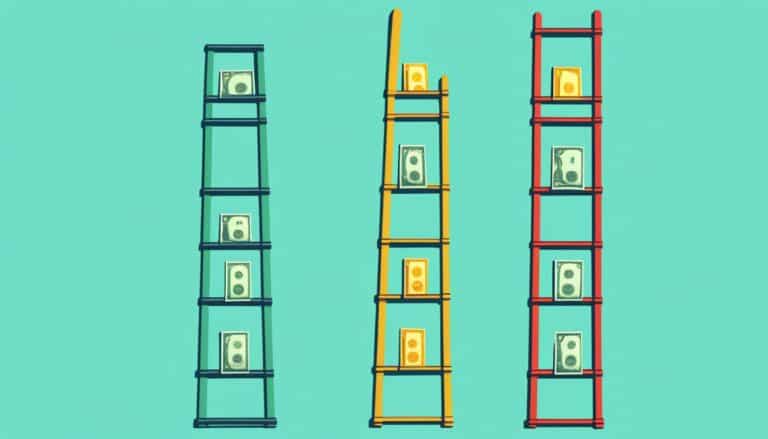Retirement Planning: Steps to Secure Your Financial Future in Canada
Preparing for retirement in Canada means building a future of ease. The money you earn now should be channeled to helping you take care of 3 classes of expenses:
- Your past expenses (debt) e.g credit card, mortgage, line of credit, etc
- Your current expenses (needs) e.g. Feeding, housing, transportation, etc
- Your future expenses (savings/retirement planning)
It’s crucial to use savings tools like RRSPs and TFSAs wisely. Read more about RRSPs and TFSAs, and which is right for you. RRSPs give you a tax break for what you save, while TFSAs are great for people with lower incomes, since you don’t pay tax on money you take out. You only pay tax on the growth on your investments whenever you make a withdrawal.
Getting the right advice and acting on accurate information should be part of the plan. This way, you can tackle issues like inflation and the high cost of living, things many Canadians worry about as they get closer to retiring. Here, you can read more about how inflation affects your retirement plan in Canada. At any time you choose to stop working, you need to be sure that you won’t run out of money. It’s a common fear among Canadians but with a custom financial strategy made early, you can enjoy your retirement without such worries in Canada.
Key Takeaways
- Set goals for a safe and secure retirement
- Discover how to leverage RRSPs and TFSAs for a secure retirement.
- Understand the financial realities Canadian retirees face, including managing inflation and healthcare costs1.
- Gain insights on preparing for a comfortable retirement tailored to your financial situation in Canada.
The Importance of Having a Retirement Plan in Canada
Thinking about your future, it’s key to have a sturdy retirement plan. This is especially true in Canada. In 1966 when the Canadian Pension Plan (CPP) was introduced, the average Canadian age was 71. Today, the average Canadian age is 81.6. Canadians now live longer and therefore are exposed to higher risk of running out of money in retirement.

Getting started with a solid plan is step one to a dream retirement. Talking to a financial advisor helps make a plan that suits you now and later. Financial markets and investments can be tricky. That’s why having a pro by your side matters. A financial advisor offers key advice on picking the right strategies for your goals. With 53% of Canadians worried about financial mistakes, having an expert is priceless.
“While most retired Canadians said they are in a strong financial position, a concerning 15% of retirees rated their financial situation as poor. Almost one-third of retirees reported their monthly expenses in retirement are higher than they expected. The study also found that those who are not yet retired may not retire as comfortably as those who are already retired. Compared to retirees, those who are not yet retired have less savings and more debt. They are more likely to expect to rely on their own savings and less likely to have a work-related pension plan. The study also found both retiree and pre-retirees may not be prepared for financial emergencies. Overall, the study paints a picture of many Canadians over the age of 50 being in a strong financial position, but a significant proportion are financially vulnerable.”
Excerpt from Ontario Securities Commision (OSC), Profiles of Retirement
Retirement Planning in Canada
To be adequately prepared for retirement, important decisions need to be made. These decisions include soul-searching, goalsetting, building savings, investing, etc. All of these must be wrapped in a solid financial plan hedged by the time you have and the resources accessible to you.
Set Goals for retirement
You can only plan the future with the resources currently available to you. So setting goals for retirement requires you to be honest with yourself by knowing where you are in your financial journey and defining where you want to be. You need to ask yourself some salient questions and write out the actual figures.
- What is your monthly income?
- What is your monthly expenses?
- What is your monthly cash flow? (Cash flow is your income minus expenses)
- How much can you afford to save without wavering?
- Are you willing to take up extra sources of income to boost your current earnings? E.g. another job, side hustle etc.
- What is the timeframe?
This goal-setting strategy follows the SMART principle – Specific, Measurable, Achievable, Relevant, and Time-bound.
As a financial advisor, these are questions I ask my clients to help them gain clarity on setting achievable goals. It is completely useless to set a savings goal that cripples your entire lifestyle. However, setting a goal also means that you may have to sacrifice some current pleasures for long-term benefits.
Do you see what I did there? 🙂 Wisdom is always somewhere in the middle.
Your goals won’t end with saving. You also have to define your investment goals. However, sticking to your savings goal is the first indicator that you take your future seriously. This singular step helps you build self-trust and gives you a clearer view of the big picture.
Saving for Retirement: How much do you need for retirement in Canada?
A survey by the Ontario Securities Commission, Profiles of Retirement, stated that 15% of Canadian retirees rated their financial situation as poor and a significant proportion of retirees above age 50 seem to be financially vulnerable. This implies that a lot of Canadians do not know the amount of money they need for retirement or maybe they do, but found it impossible to save. I have heard a lot of people carelessly use C$1 million as the ultimate figure for retirement. But how did they get to this figure? Is this figure achievable for everyone? I doubt it.
At this point, you already defined your savings goal. If you haven’t, asking yourself the following questions will help you know how much you need for retirement.
Some experts recommend that the optimal estimate for retirement is a multiplication of your current monthly expenses by 12 months. Then, multiply the product by 25 years. This strategy assumes that retirement time is 25 years or below. While this might be good enough hypothetically, it might require some customization to capture the desires of different people. Here are a few questions to ask yourself to arrive at a more customized retirement amount.
At retirement, do I plan to engage in a hobby and what’s the cost of your hobby?
At retirement, some people plan to live a lifestyle that is completely different from how they currently live. You may want to live in a different country, become a nomad, or start an expensive hobby. For instance, I know a retiree (Let’s refer to him as Mr. John) who started wood carving as a hobby. He turned the entire basement of his house into a workshop and had to invest in some electrical equipment to aid his craft. That’s a perfect example. Your desires have to be planned into your finances.
Will You have other sources of income at retirement?
Having other sources of income at retirement can change your plans. For instance, Mr. John, above, might choose to sell some of his woodwork and earn an income. Also, assuming his hobby didn’t require a large space, he could decide to rent out his basement and earn an income.
Time: How much time do You have?
Time is a big factor in retirement planning. That is why young Canadians are often advised to start early to take advantage of compound interest and other financial concepts. Someone who starts retirement planning at age 35 will likely rip higher benefits relative to someone who starts at age 40, assuming they are privy to the same resources.
Eligibility for Government benefits: Which Government benefits will You be eligible for?
Canadian programs specifically providing income support for the aged, disabled, and survivors are collectively called Canada’s Public Pensions System. Government benefits available to Canadians at retirement include the Canadian Pension Plan (CPP), Old Age Security (OAS), and Guaranteed Income Supplement (GIS). Let’s look into each of them briefly.
Canadian Pension Plan (CPP) is a monthly, taxable benefit that replaces part of your income when you retire. Retirees who qualify receive the CPP retirement pension for the rest of their lives. To qualify for the CPP retirement pension, one must (i) be at least 60 years old and (ii) have made at least one valid contribution to the CPP. The standard age to start receiving pension in Canada is 65 but you can start receiving as early as age 60. The time you start receiving pension benefits affects the amount you receive. If you start late, you will receive a relatively larger monthly amount. The age threshold for this is 70; waiting beyond age 70 will not increase the monthly amount received. Apart from the time you choose to start receiving your retirement pension, the amount you receive can also be affected by the following factors:
- how much and for how long have you contributed to the CPP
- your average earnings throughout your working life
Old Age Security (OAS) is a monthly benefit paid to Canadian residents who are 65 years and above as long as they meet residency requirements and do not have high taxable income. You can receive the OAS even if you’ve never worked or are still working. Apart from the age requirement, if you live in Canada, to be eligible you have to
- be a Canadian citizen or a legal resident at the time your OAS pension application is approved
- have resided in Canada for at least 10 years since the age of 18
The OAS amount you receive depends on your residency status and annual taxable income.
Note: other conditions apply for Canadians living outside Canada or Canadians working for a canadian employers outside Canada.
Guaranteed Income Supplement is a non-taxable monthly income available to Old Age Security (OAS) pensioners with low income.
Risk Tolerance: How much risk can you tolerate?
Your risk tolerance is one way to decide on your investment portfolio. The more risk you are willing to take, the higher the “possibility” of your gains. However, more risk doesn’t necessarily translate to more gains. Wisdom is always in the middle. In my practice, aligning my client’s risk appetite with potential risk to design a formidable financial plan is a daily go-to skill.
What investment vehicles are you most comfortable to use for your retirement planning?
In Canada, you can use registered accounts such as TFSA, RRSP, and RESP. Check out my article on TFSA vs RRSP, to know which is better for you and when. In the same vein, a life insurance product can also be used as a tax-free investment product. Book a call with me to learn more about how this works.
Do you prefer to DIY or use the service of a financial advisor?
The need for a financial advisor is often a big debate but it doesn’t have to be. Like any other profession, people seek expert guidance when they are not comfortable to DIY. An Ipsos survey shows that only 51% of Canadians would describe themselves as being knowledgeable about investing. Even among investors, 1 in 3 (32%) admits that they don’t feel confident about investing. See excerpt from Ipsos
Therefore, in situations where people genuinely need help to invest for retirement, they should consider the service of a financial/investment advisor.
Investing for Retirement
Your retirement investment goals should align with the kind of lifestyle you want at retirement. If you desire to live on your terms and not be financially constrained to make decisions, then you have to start investing early. On the other hand, if you desire a retirement where you just have enough money to pay your bills and get by daily, the CPP may be enough.
“A new Ipsos poll conducted on behalf of CIBC Investor’s Edge reveals that only about half (48%) of Canadians put at least some money into investments, each year, and just a small majority (56%) are comfortable investing their own money, a figure which climbs to three-quarters (75%) among investors. The one in four (25%) investors who do not feel comfortable investing their own money most frequently point to a lack of knowledge (65%) and/or fear of losing money (57%) as reasons for this sentiment.
Clearly, knowledge is important when it comes to investing, but the poll reveals that many investors lack confidence in this area – one in three (32%) concede they don’t feel knowledgeable about investing. Around two in five aren’t sure what ETF stands for (38%) and/or don’t know what dollar cost averaging is (42%)”
Ipsos poll
Also, you should consider investing your money in a tax-efficient way. As detailed in RRSP vs TFSA, different investment vehicles have different advantages and, depending on your current income, you should be choosing between them. Here are the investment vehicles mentioned in this article and their advantages
Registered Retirement Savings Plan (RRSP) – “Tax later”
Tax deductible: Money contributed to your RRSP for the year is deducted from your taxable income. If you withdraw money from your RRSP, either capital gains or capital, the amount withdrawn is added to the taxable income for that year and taxed accordingly.
Tax-free savings Account (TFSA) – Tax-advantaged
Money contributed to TFSA is not tax-deductible i.e. you have already paid tax on it. There is a set contribution room for each year. Both the capital and capital gains can be withdrawn tax-free.
Life Insurance Benefit – Tax Advantaged
The benefit of a life insurance benefits is not taxable. Both the Cash Value in the policy and the death benefit payout are not taxable.
Delayed Gratification for Retirement Saving and Investing
Delayed gratification, or deferred gratification, is the resistance to the temptation of immediate pleasure in the hope of obtaining a valuable and long-lasting reward in the long term. Especially for people who do not have wealth handed down to them, this concept holds true for wealth building. It takes a lot of willpower to deny yourself some pleasures to be able to build your savings. A 2024 survey by Forbes revealed that 38% of respondents set “Improve finances” as a new year resolution in 2024. The survey also reveals that, by the 4 month, 66% of respondents abandoned their New Year resolution. Saving is at the center of every financial plan. You need money to make money.

Navigating Canadian Retirement Income Sources
As you get ready to retire, it’s key to know about Canada’s retirement income sources. These include the Canada Pension Plan, Old Age Security, and the Guaranteed Income Supplement. Each is made to give you stability and support in your later years.
Exploring the Canada Pension Plan Benefits
The Canada Pension Plan (CPP) is vital for retirement planning in Canada. You can start receiving benefits as early as 60. By waiting until you’re 70, your payments could be much higher. For example, at 65, you could get up to $1,364 per month. Waiting longer increases your benefits by 0.7% each month, up to 42% more if you start at 70.
This benefit is a key part of your retirement savings. It gives you steady income based on your work history.
Maximizing Old Age Security and Guaranteed Income Supplement
Starting at 65, Old Age Security (OAS) adds another layer of financial protection for Canadian seniors. You could receive up to $713.34 a month, which goes up to $784.67 by age 75. But, if you earn more than $86,912 a year, your OAS could be reduced.
If you’re a low-income senior, the Guaranteed Income Supplement (GIS) adds extra help. It makes sure no senior lives in poverty. OAS and GIS together offer vital government help based on your financial needs in retirement.
Understanding and using these public pension benefits in your retirement plan is critical. By getting the most out of the Canada Pension Plan, Old Age Security, and the Guaranteed Income Supplement, you prepare for a secure and comfortable retirement.
Estimating Your Retirement Savings Needs
Figuring out how much money you need for retirement in Canada can seem hard. A retirement calculator helps you see how much you need for a good life. It takes into account things like inflation and how much your investments might grow.
Anticipating Changes in Living Standards and Inflation
It’s important to adjust your savings for inflation because your money might buy less over time. The average inflation rate has been about 2.6% a year. With inflation going up, it’s key to have a strong saving plan. Putting in as much money as your employer will match in an employer-sponsored RRSP is a smart move.
Your living costs, like health care and housing, will likely change when you retire. A retirement calculator helps you plan for these changes. It shows you how housing and health care costs might affect your savings.
Understanding Compounding and Its Effect on Your Savings
Compounding can make your retirement savings really grow. It’s all about how your earnings can earn more over time. Seeing your money grow this way might make you want to keep investing more, especially after looking at your expected lifespan9.
Seeing how much your investments could grow with compound interest can be really inspiring. If you keep adding money to your retirement account and follow expert advice, like making extra contributions after 50, you’ll see a big increase in your savings. This can help you have a worry-free future.
The Flexibility of Tax-Free Savings Accounts (TFSA)
I want to really hammer on this one.
The Tax-Free Savings Account (TFSA) is different since it’s very flexible and you don’t pay penalties when you take money out. Once you hit 18, you can start putting money into a TFSA. Here, your investment gains and the money you take out don’t add to your taxable income. The best part of a TFSA is its adaptability; you can use the money anytime without facing taxes. This makes TFSAs a solid pick for saving short-term or even for longer goals.
Using both RRSP and TFSA in your retirement plan means you can save more effectively and handle your taxes better. It’s smart to begin early. Think about your retirement life, consider inflation, and your future spending to pick the best strategy for you.
In conclusion, it’s crucial to understand the unique perks of both the Registered Retirement Savings Plan and the Tax-Free Savings Account for retirement. Making a wise decision based on your financial needs and goals ensures a secure and thriving future. Pick the option that best suits your situation to maximize your retirement savings.
Conclusion
In this post, we have been able to establish that time is an important factor in retirement planning. We have also highlighted some salient questions you can ponder on, to help you get actual data that can help you plan for the future. Most of the ideas shared in this post are relatable to an average Canadian, and you can choose to take action alone. If you are not comfortable with making personal finance decisions such as the ones shared in this post, please consult your financial advisor.
Disclaimer: The information shared in this post are for educational purposes and should not be taken as financial advice. Please do your due diligence before making any financial decisions.
FAQ

Ogunjobi Oluwamuyiwa Felix preferred to be called Muyiwa Felix, is a personal finance coach and Insurance advisor. He creates content that addresses the core of personal finance in Canada, the United States, and the world at large. Daily, he meets up with clients who are interested in financial risk management, income protection, wealth-building, retirement planning, and tax-efficient investing strategies.






